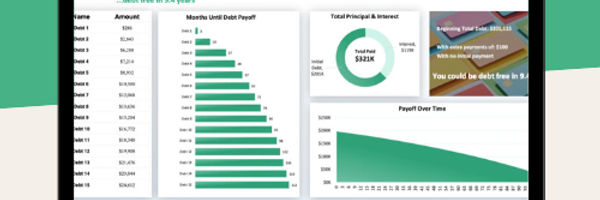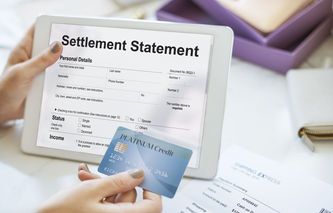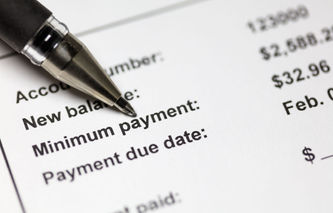The average American carries a great deal of credit card debt, and that can sometimes lead to financial stress, payment problems, and bankruptcies. In this article, we're going to discuss some of the options individuals have to manage this potential problem.
The options we'll discuss include: credit repair services, self help, and even budgets. These are all part of a do-it-yourself credit card debt control process. Getting out of debt and staying out of debt takes a lot of self-control. It's easy to overspend; cutting back is the hardest part.
Financial troubles begin when spending increases or household income decreases. Loss of a job, spending beyond one's means, or racking up debt on multiple credit cards, can send credit card debt out of control. Individuals may find themselves wondering how they're going to pay off their balance, and they're not always sure where to turn.

Lay out your credit card debt with the minimum payments and interest to see how long it will take to pay off!
What you will get:
Interactive dashboard
Customizable to your needs
Stay on track with charts and graphs
Suitable for up to 16 or 32 debts!

Do It Yourself Help
The method discussed below is a two-step process. Not everyone is successful with a do-it-yourself approach. There are external resources that can help too. Using a credit counselor can provide individuals with professional guidance and financial education.
The method below addresses two obstacles: the credit card debt itself, and the possible need for credit repair.
Eliminating Credit Card Debt
Short of bankruptcy, there is simply no way to reduce credit card debt without ensuring the money charged to the card is less than the money paid to the issuing company each month.
<This might seem obvious, but many individuals don't follow this rule, and quickly find themselves overwhelmed by debt. The objective here is to figure out how to make payments to credit card companies that are greater than credit card charges. One effective suggestion is this: Individuals should run their personal finances like a business.

Lay out your credit card debt with the minimum payments and interest to see how long it will take to pay off!
What you will get:
Interactive dashboard
Customizable to your needs
Stay on track with charts and graphs
Suitable for up to 16 or 32 debts!

Essential versus Discretionary Charges
Businesses make prudent purchase decisions and completely understand the long-term implications of each choice. It's important to separate the purchases that are essential to the smooth operation of a household from those that are unnecessary, wasteful, or extravagant.
To get a good view of their business operations, most financial officers rely on a series of reports or financial statements that provide them with insights into the fiscal health of their businesses. Individuals trying to figure out where their money goes each month need to arm themselves with the same types of tools. The most important of which is a household budget.
Budgets
This website has an entire series devoted to the topic of budgets and budgeting. A household budget is essential to understanding a family's sources of income and expenses. A very good software tool is Intuit's Quicken. While this product might cost anywhere from $40 to over $100, the insights it provides are well worth the money.
Individuals that aren't ready to pay for a software application can download the budget spreadsheet we've published for free. For some individuals, the spreadsheet is all they will ever need. For others it is a good place to start thinking about how the home's finances can be better managed.
Credit Repair
The first phase of this approach is getting future bills under control by not overspending. Once they're under control, it's possible to pay down the outstanding credit card debt. The second step in this process has to do with the accuracy of a credit report.
The truth be told, the only thing an outsider can help with is repairing inaccuracies in the report itself. They cannot "clean" a report, and signing documents containing false claims is illegal.
Requesting a Credit Report
By law, everyone is entitled to a free credit report every twelve months. Individuals are also entitled to a free report anytime a company takes adverse action against them. That's the law, and it's there to protect everyone from an inaccurate credit history. Individuals are also allowed to dispute inaccurate information for free.
Under the Fair Credit and Reporting Act, both the credit reporting company (Experian, Equifax, and TransUnion) and the organization providing the disputed information, such as a credit card company, are responsible for correcting information on the report.
Fixing Credit Reports
Once a copy of a credit report is received, it needs to be looked over carefully for inaccuracies. If a problem with the credit report is found, then it needs to get fixed. That means writing to the credit reporting agency, and possibly the company providing the inaccurate information. Whenever writing to these companies, it's important to keep the letter short and simple. Discuss the facts surrounding the problem and provide copies of any documentation supporting a claim.
When writing the letter, be very specific as to the exact item in dispute. Provide information that supports the claim, and ask the credit reporting company to please remove or correct the item immediately.
All companies reporting information to credit agencies are required to investigate claims in a timely fashion, usually within 30 days. They are also required to report their findings back to the credit reporting agency.
After the investigation is complete, the reporting agency must provide individuals with the results of their findings in writing. In addition, if requested, the agency must also send a corrected copy of the report to anyone that was sent a copy during the past six months (two years for employment purposes).
Fixing Accurate Information
If the information on a report is accurate, the only way to "fix" the report is by establishing a good payment pattern over time. Most negative information on a credit report will stay there for seven years. In the case of a bankruptcy, the information stays on a report for ten years.
Individuals that follow their budget, and pay down their credit card balances will soon see this good behavior reflected in their reports. The sooner this process is started, the faster credit ratings will recover.
Dispute Letters to Credit Agencies
Anyone that finds inaccurate information on their credit report can use the sample credit dispute letter that we make available for download. This sample letter should provide insights into the types of information to include, and give everyone a good starting place for their letter. Finally, keep copies of everything sent to these companies in case a question about a claim comes up at a later date.




